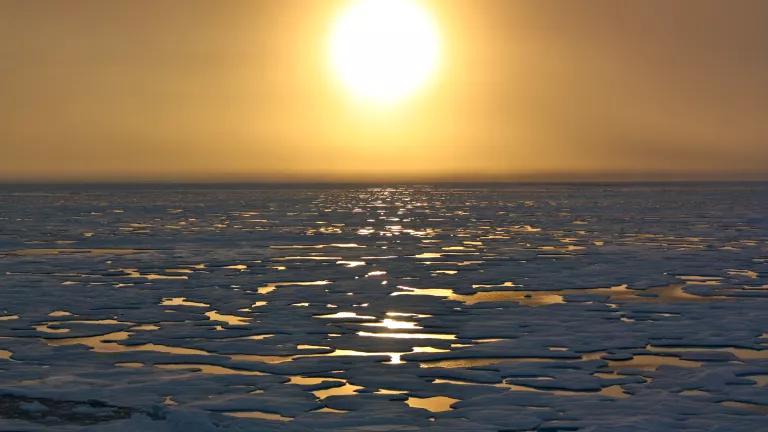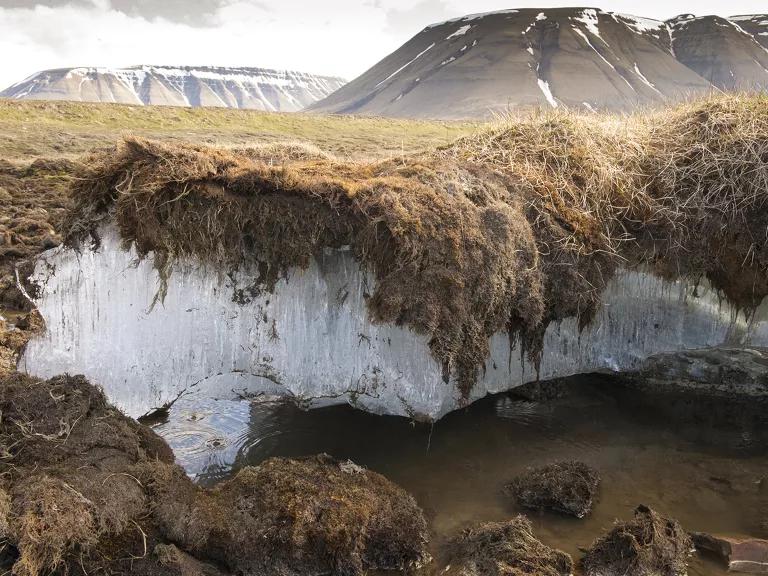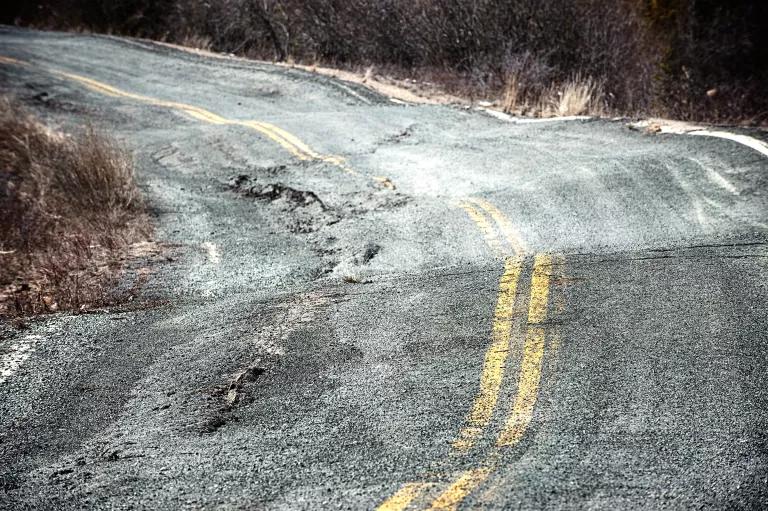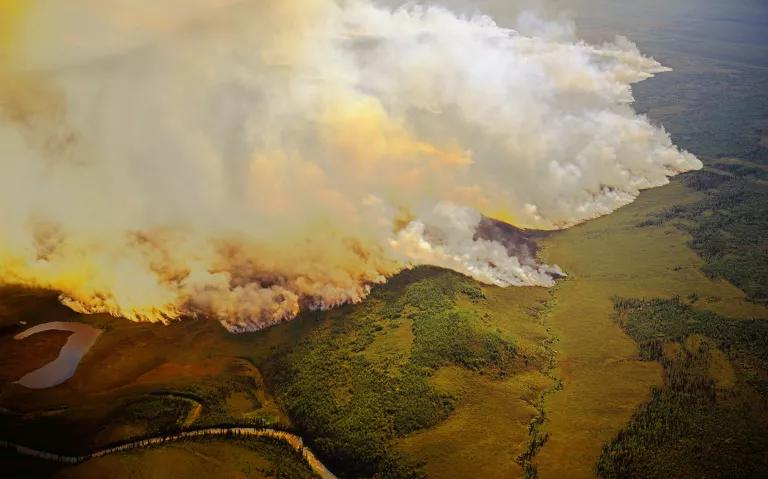Permafrost: Everything You Need to Know
The “permanently” frozen earth at our planet’s poles and in other cold climes is thawing, with big consequences to our climate, ecosystems, and health.

NASA
Jump to Section
Earth’s permafrost is turning out to be not so permanent in many parts of the world. As global temperatures rise, the once always-frozen ground that covers a good chunk of the world’s northern latitudes is thawing. That might not sound like such a big deal, but as our underground ice turns to squelchy muck, it’s exposing long-hidden threats to our climate, ecosystems, and health. Here’s a look at what permafrost is, why it matters, and what we can do about it.
What Is Permafrost?
Permafrost is any type of ground—from soil to sediment to rock—that has been frozen continuously for a minimum of two years and as many as hundreds of thousands of years. It can extend down beneath the earth’s surface from a few feet to more than a mile—covering entire regions, such as the Arctic tundra, or a single, isolated spot, such as a mountaintop of alpine permafrost.
How Does Permafrost Form?
Just as a puddle of water freezes on a frigid winter night, water that is trapped in sediment, soil, and the cracks, crevices, and pores of rocks turns to ice when ground temperatures drop below 32°F (0°C). When the earth remains frozen for at least two consecutive years, it’s called permafrost. If the ground freezes and thaws every year, it’s considered “seasonally frozen.”
Where Is Permafrost Found?
About a quarter of the entire northern hemisphere is permafrost, where the ground is frozen year-round. It’s widespread in the Arctic regions of Siberia, Canada, Greenland, and Alaska—where nearly 85 percent of the state sits atop a layer of permafrost. It’s also found on the Tibetan plateau, in high-altitude regions like the Rocky Mountains, and on the floor of the Arctic Ocean as undersea permafrost. In the southern hemisphere, where there’s far less ground to freeze, permafrost is found in mountainous regions such as the South American Andes and New Zealand’s Southern Alps, as well as below Antarctica.

Permafrost melting in the arctic region of Svalbard, Norway
Nature Picture Library via Alamy
How Much of the Earth’s Surface Is Permafrost?
According to the National Snow and Ice Data Center (NSIDC), permafrost covers an estimated 9 million square miles in the northern hemisphere—nearly the size of the United States, China, and Canada combined. However, that footprint is rapidly shrinking. While global warming is upping temperatures around the world, the Arctic is warming twice as fast as anywhere else—and faster than it has in the past 3 million years. And when surface air temperatures rise, below-ground temperatures do, too, thawing permafrost along the way. NSIDC scientists estimate there is now 10 percent less frozen ground in the northern hemisphere than there was in the early 1900s. One recent study suggests that with every additional 1.8°F (1°C) of warming, an additional 1.5 million square miles of permafrost could eventually disappear. Even if we meet the climate targets laid out during the 2015 Paris climate talks, the world may still lose more than 2.5 million square miles of frozen turf.
What Are the Impacts of Permafrost Thaw?
The loss of greenhouse gas stores
When plants and animals die, the microbes that decompose their bodies release carbon dioxide, methane, and other global warming gases into the air. A deep freeze effectively hits the pause button on that process and preserves organisms and the gases they would otherwise emit underground. When frozen soil thaws, the microbial decomposition of those organic materials—and the release of greenhouse gases—starts anew.
Packed with many thousands of years of life, from human bodies to the bodies of woolly mammoths, permafrost is one of earth’s great stores of global warming gases. Indeed, permafrost in the Arctic alone is estimated to hold nearly twice as much carbon as exists in the atmosphere now, as well as a sizable amount of methane—a powerful greenhouse gas that traps more than 80 times more heat on the planet than carbon does. But our warming world may jeopardize these stores. Estimates on how much carbon and methane will be released by thawing permafrost vary, but according to a 2015 study titled "Climate Change and the Permafrost Carbon Feedback," published in Nature, as much as 92 billion tons of carbon could be emitted between now and 2100. For perspective, that’s equal to nearly 20 percent of all global carbon emissions since the start of the Industrial Revolution.
The problem doesn’t end there, however. Looking forward, as thawing permafrost dumps more of its massive supply of greenhouse gases into the air—warming the climate and melting even more carbon- and methane-emitting permafrost—an unstoppable feedback loop may be triggered, one that could ultimately turn the Arctic from a carbon sink that absorbs emissions to a carbon source.
Carbon and methane aren’t the only pollutants trapped in permafrost. A 2018 study titled "Permafrost Stores a Globally Significant Amount of Mercury," published in Geophysical Research Letters, found that Arctic permafrost is a massive repository of natural mercury, a potent neurotoxin. Indeed, it’s estimated that some 15 million gallons of mercury—or nearly twice the amount of mercury found in the ocean, atmosphere, and all other soils combined—are locked in permafrost soils. Once released, however, that mercury can spread through water or air into ecosystems and potentially even food supplies.
Crumbling infrastructure
In northern Russia, city buildings are crumbling. In Alaska, roads are turning into rollercoasters. When water turns into ice underground, it expands and the ground swells. When water thaws, the ground contracts, which can make the earth crack or cave in—as exemplified by potholes that form in the spring. About 35 million people live in a permafrost zone, in towns and cities built on top of what was once considered permanently frozen ground. But as that solid ground softens, the infrastructure these communities rely on grows increasingly unstable.

Permafrost damaged roads, Yellowknife, Northwest territories
Ryerson Clark/iStock
In Canada, disappearing permafrost is estimated to cause tens of millions of dollars in damage to public infrastructure across Northwestern Territories each year. And in Alaska, one study puts the cost of repairing public infrastructure―such as roads, train lines, buildings, and airports—damaged by thawing permafrost and other climate-related factors at as much as $5.5 billion by the end of this century. Meanwhile, as the fossil fuel industry continues to drive climate change, contributing to the warming of the planet and the melting of the world’s permafrost, it only increases the odds that its very own Arctic-based energy infrastructure will fail, imperiling local ecosystems with oil and gas leaks.
Altered landscapes
Thawing permafrost alters natural ecosystems in many ways as well. It can create thermokarsts, areas of sagging ground and shallow ponds that are often characterized by “drunken forests” of askew trees. It can make soil—once frozen solid—more vulnerable to landslides and erosion, particularly along coasts. As this softened soil erodes, it can introduce new sediment to waterways, which may alter the flow of rivers and streams, degrade water quality (including by the introduction of carbon), and impact aquatic wildlife.

A forest fire in the Nulato Hills, Koyukuk National Wildlife Refuge, Alaska
P.A. Lawrence, LLC./Alamy
Wetlands also deteriorate along with permafrost, as the water sinks further underground without a frozen buffer to keep it in place. This can create drier terrain more susceptible to wildfires, which expose even more permafrost to warming. The loss of permafrost can also contribute to sea level rise. Indeed, it’s estimated that if all of the earth’s permafrost thaws, sea levels could rise by as much as four inches, enough to double the flood risk for cities like San Francisco, Seattle, and Los Angeles.
Risk of disease?
Just as permafrost locks in carbon and other greenhouse gases, it can also trap—and preserve—ancient microbes. It’s believed that some bacteria and viruses can lie dormant for thousands of years in permafrost’s cold, dark confines before waking up when the ground warms. As scary as the notion of “zombie” pathogens sounds, however, questions remain about how great a risk these ancient microbes pose. A 2016 anthrax outbreak in Siberia, linked to a decades-old reindeer carcass infected with the bacteria and exposed by thawed permafrost, demonstrated the potential threat. But when it comes to other diseases, such as smallpox and the 1918 Spanish flu—known to exist in the frozen tundra, in the mass graves of those killed by the disease—scientists are still uncertain how likely these pathogens are to cause outbreaks. What is certain, however, is that developing the Arctic—and extracting millions of tons of permafrost to mine for precious metals and petroleum—will increase human contact with thawed, ancient, and possibly zombie pathogens.
How Can We Stop Permafrost from Thawing?
For most of us, the tundra and the permafrost beneath it may seem a million miles away. But no matter where we live, the everyday choices we make that contribute in some small way to climate change collectively can add up to a big impact on the world’s coldest climes. By reducing our carbon footprint, investing in energy-efficient products, and supporting climate-friendly businesses, legislation, and policies, we can help preserve the world’s permafrost and avert a vicious cycle of an ever-warming planet.
This NRDC.org story is available for online republication by news media outlets or nonprofits under these conditions: The writer(s) must be credited with a byline; you must note prominently that the story was originally published by NRDC.org and link to the original; the story cannot be edited (beyond simple things such as grammar); you can’t resell the story in any form or grant republishing rights to other outlets; you can’t republish our material wholesale or automatically—you need to select stories individually; you can’t republish the photos or graphics on our site without specific permission; you should drop us a note to let us know when you’ve used one of our stories.
How to Find Relief During Summer Heat Waves in the City
What Are the Solutions to Climate Change?
As Temperatures Soar in India, One City’s Efforts Are Saving Lives